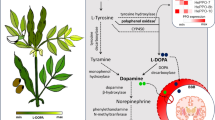Abstract
Extracts of cotyledons of Brassica napus plants (seed progenies of doubled haploid plants) were separated by electrophoresis on polyacrylamide gels and stained for acid phosphatase (ACP-E.C. 3.1.3.2.) and leucine aminopeptidase (LAP-E.C. 3.4.11.1.) enzymes to investigate the possibility of utilising isozymes as markers of homogeneity (purity) of plant populations. One zone of activity for acid phosphatase and two zones of activity for leucine aminopeptidase were identified on gels, some variation in isozyme patterns occurred in several androgenetic lines. This method is appropriate and consistent for testing the homogeneity of breeding lines-progenies of double haploid (D.H.) plants.
Similar content being viewed by others
References
Arús P and Orton TJ (1983) Inheritance and linkage relationships of isozyme loci in Brassica oleracea. J Heredity 74: 405–412
Arús P, Quiros CF, Chevre AM, Delourme and Eber F (1991) Procedures of starch gel electrophoresis of isozymes in Brassica. INRA Station D'Amélioration des Plantes
Arús P, Shields CR and Orton TJ (1985) Application of isozyme electrophoresis for purity testing and cultivar identification of F1 hybrids of Brassica oleracea. Euphytica 34: 651–657
Arús P, Tanksley SD, Orton TJ and Jones RA (1982) Electrophoretic variation as a tool for determining seed purity and for breeding hybrid varieties of Brassica oleracea. Euphytica 31: 417–428
Boháčová I (1990) Výzkum metod kultivace řepky ozimé in vitro. ZZ, VŠÚTPL Šumperk, ŠS Slapy u Tábora
Delourme R, Foisset N (1991) Isozyme variability in Brassica napus. Proceedings of 8th International Rapeseed Congress, 9–11 July 1991, Saskatoon, Canada
Hames BD and Rickwood D (eds) (1990) Gel Electrophoresis of Proteins: A Practical Approach. IRL Press, Oxford
Laemmli UK (1970) Cleavage of structural proteins during the assembly of the head of bacteriophage T4. Nature 227: 680–685
Lönnendonker N and Schieder O (1980) Amylase isoenzymes of the genus Datura as a simple method for an early identification of somatic hybrids. Plant Sci Lett 17: 135–139
Moore GA and Collins GB (1983) New Challenges Confronting Plant Breeders. In: Tanksley SD and Orton TJ (eds) Isozymes in Plant Genetics and Breeding, Part A, pp 25–58. Amsterdam: Elsevier Sci Publ
Mündges H, Köhler W and Friedt W (1990) Identification of rapeseed cultivars (Brassica napus) by starch gel electrophoresis of enzymes. Euphytica 45: 179–187
Nijenhuis BTE (1971) Estimation of the proportion of inbred seed in Brussels sprouts hybrid seed by acid phosphatase isoenzyme analysis. Euphytica 20: 498–507
Shields CR, Orton TJ and Stuber CW (1983) An Outline of General Resource Needs and Procedures for the Electrophoretic Separation of Active Enzymes from Plant Tissue. In: Tanksley SD and Orton TJ (eds) Isozymes in Plant Genetics and Breeding, Part A, pp 443–468. Amsterdam: Elsevier Sci Publ
Sundberg E and Glimelius K (1986) A method for production of interspecific hybrids within Brassiceae via somatic hybridization, using resynthesis of Brassica napus as a model. Plant Sci 43: 155–162
Sundberg E and Glimelius K (1991) Production of cybrid plants within Brassicaceae by fusing protoplasts and plasmolytically induced cytoplasts. Plant Sci 79: 205–216
Truco MJ and Arús P (1987) Comparative study on the isozymes of Brassica campestris, B.oleracea and B.napus. Cruciferae Newsletter 12: 18–19
Vallejos CE (1983) Enzyme Activity Staining. In: Tanksley SD and Orton TJ (eds) Isozymes in Plant Genetics and Breeding, Part A, pp 469–516. Amsterdam: Elsevier Sci Publ.
Vaughan JG and Waite A (1967) Comparative electrophoretic studies of the seed proteins of certain species of Brassica and Sinapis. J Exp Bot 18: 100–109
Webb EC (1984) Enzyme Nomenclature. Acad Press,Inc., London
Wendel JF and Weeden NF (1990) Visualization and Interpretation of Plant Isozymes. In: Soltis DE and Soltis PS (eds) Isozymes in Plant Biology, pp 5–45. London: Chap. Hall
Wills AB, Fyfe SK and Wiseman EM (1979) Testing F1 hybrids of Brassica oleracea for sibs by seed isoenzyme analysis. Ann Appl Biol 91: 263–270
Wills AB and Wiseman EM (1980) Acid phosphatase isoenzymes of Brassica oleracea seedlings and their applications to sib testing in F1 hybrids. Ann Appl Biol 94: 137–142
Woods S and Thurman DA (1976) The use of seed acid phosphatases in the determination of the purity of F1 hybrid Brussels sprout seed. Euphytica 25: 707–712
Author information
Authors and Affiliations
Rights and permissions
About this article
Cite this article
Čurn, V. Acid phosphatase and leucine aminopeptidase isozymes as biochemical markers of homogeneity in oil seed rape androgenetic lines. Plant Growth Regul 16, 59–63 (1995). https://doi.org/10.1007/BF00040508
Received:
Accepted:
Issue Date:
DOI: https://doi.org/10.1007/BF00040508




